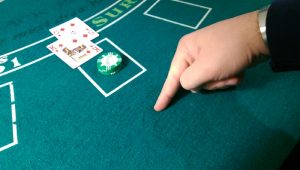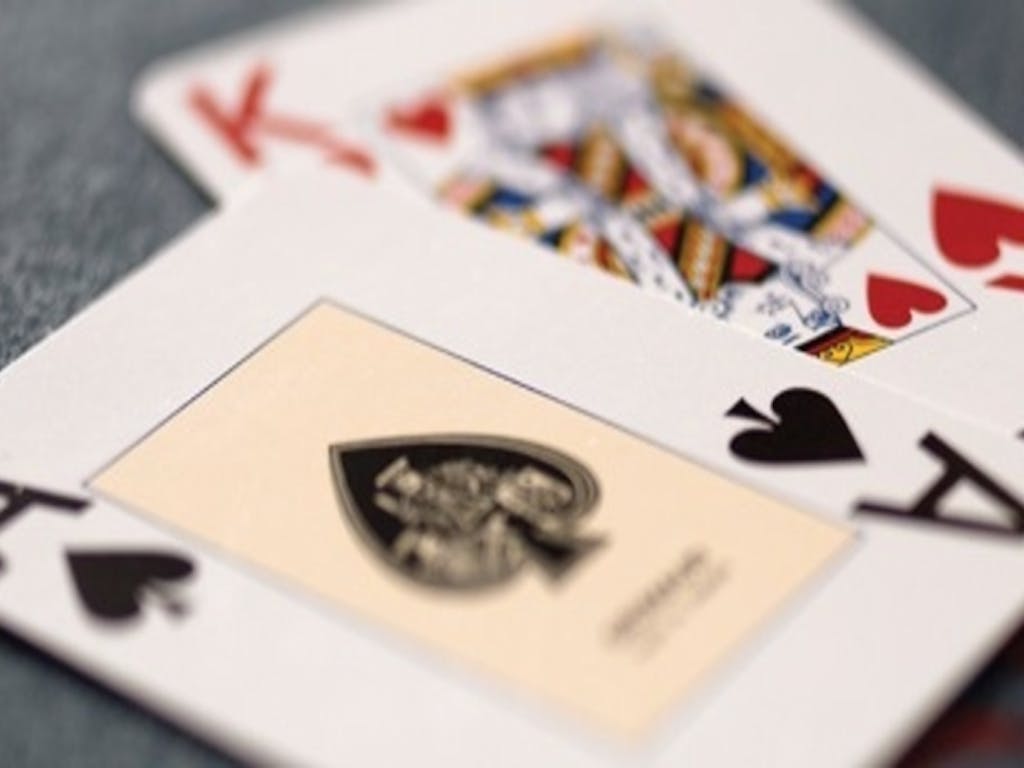Blackjack Surrender Signal
Posted By admin On 29/07/22To surrender in a face-down game, draw an imaginary straight line with your index finger. Face-up blackjack hand signals. Hit – in face-up blackjack, the hand signal for hit is to tap the table with your finger or wave your hand towards yourself. Stand – the blackjack hand signal for stand in a face-up game is to wave your hand over your cards.
Let’s face it, sometimes we are just having an off day, with bad hand after bad hand. And sometimes, surrendering is our best bet; an occasionally viable tactic in games of blackjack which allow the player to do so. Surrendering, as we explain in our glossary of blackjack terms, refers to the offer in some games styles of blackjack (mainly American versions) which allows players to forfeit their hand in the current round and get back half of their original wager. The option to do so is offered by some land-based casinos, and the majority of online casinos.
- So the other day I was playing blackjack at another casino in the Caribbean.in Belize, to be exact. The dealer did not take a hole card, which I, being American, am not really used to, but it's going OK so far. I get dealt a 16 against a dealer 10, and ask the dealer if I can surrender. She says yes and gives me half of my bet.
- How about a palm up waving of the hand to and fro while saying 'I surrender'. The dealer will usually confirm that you indeed wish to surrender before taking half of your bet.
If you have a hard hand of 14 and the dealer has an Ace on show, surrendering in order to retrieve half of your bet instead of quite possibly losing it all can be appropriate. Surrendering is a feasible option if you are dealt a poor hand and the dealer has a strong hand, but it has to be used in the right situation. Otherwise, it’s money down the drain that could have won.

Available Surrendering Options
Surrendering is only available as a first decision of a two-card hand. It is usually only offered in hole-card games (but see below for variations), where the dealer draws two cards and may or may not peek at the hole (face down card), before players make their decisions. But in general, surrendering will usually only be available directly after the dealer has checked for blackjack.
The variations we speak of are early and late surrender. Late surrender, explained above, refers to being able to do so in hole card games, only after the dealer has checked for a blackjack. It is the most common option at all types of casinos. If the dealer checks and does indeed have a blackjack, surrendering is thus made unavailable.
Alternatively, early surrender is when you are allowed to surrender before the dealer checks (or if the dealer doesn’t check at all) for blackjack in hole-card games, or in a no-hole-card game, where the dealer does not draw a second card until all players have acted. As you can see, early surrender is significantly more favourable to the player than late surrender is, which is why early surrender is not often available.
When to Consider the Move
As mentioned above, surrendering can be an appropriate play if used at the right time. It may seem like a cowardly move which is not progressive or beneficial in the long-run, and it is if not used correctly: you’re wasting hands that have the potential to win. Only consider surrendering as a last possible resort on the very worst hands.

There are only a few hands in which surrendering can be considered (late surrender). If you are lucky enough to be playing with the rare early surrender option, this allows for more flexibility and you might consider surrendering medium to low strength hands if the dealer holds an Ace (and the hole-card has not yet been examined).
Poor Hands to Consider for Early Surrender
- You hold a total of 12 to 17 against a dealer’s Ace.
- You hold a total of five to seven against a dealer’s Ace.
- You hold a total of 14 to 16 and the dealer has a Ten.
- You hold a total of 16 and the dealer shows a Nine.
Poor Hands to Consider for Late Surrender
- Your hand totals a hard-15 and the dealer holds a 10-valued card or an Ace.
- Your hand totals a hard-16 and the dealer holds a Nine, 10-valued card or Ace.
- Your hand totals a hard-17 and the dealer holds an Ace.
How to Surrender in Blackjack
At most land-based casinos, BJ tables will have rules on a placard for players to view, but it is still worth confirming with the dealer before playing, just to make be certain surrendering (or any other option for that matter) is available. Online casinos will typically label each game with the available options which can be checked before, during and after play.
To surrender at an online table, click the corresponding surrender button. To do so at a land-based BJ table, wait until you have the dealer’s attention after receiving your cards, and verbalise your intentions (with a possible follow-up hand signal). There is no standard hand signal for surrendering, but players will usually move a finger from right to left on the table above their cards (drawing an imaginary line). We suggest making your surrendering intentions clear by first saying so, because signalling a surrender with your hands can be sometimes be misinterpreted as a hit, so verbalisation is really the best way to go.
Once recognised, the dealer will remove your cards from the table, take half your bet and return the other half to you. Essentially, you have forfeited the opportunity to play out your hand and the casino keeps half of your bet while the other half acts as a push/stand-off/tie; whatever you want to call it.
Rules of Play
What is Late Surrender?
Late Surrender on Blackjack is the option as a player to save half (½) their original wager by throwing in their hand; thus forfeiting the other half (½) of their original bet. Late Surrender only applies to blackjack, Perfect Pairs and Lucky Lucky games only.
When can the player use the Late Surrender option?
Only on the first two cards of the player’s hand on any total and against any dealer up card once the dealer has determined that he/she does not have a natural 21 (blackjack).
What is the dealing procedure?
The procedure will be the same as surrender on Spanish 21, when it is the player’s turn to act on their first two cards the player may choose to forfeit half (½) the original blackjack wager. When a player chooses to surrender, the dealer will take half (½) the player’s bet and the cards, returning the other half (½) back to the player; this terminates the player’s interest in the hand. The player can direct their decision to the dealer verbally or using a hand signal (i.e. scratching the table), there must be a clear understanding of the player’s decision by the dealer before proceeding.
Blackjack Surrender Hand Signal

Blackjack Surrender Hand Signal
Are bonus bets affected?
All bonus bets are treated as a separate wager and their procedure and order of procedure remains the same. If a player surrenders their hand on Super 7’s the hand is no longer eligible for any additional bonus payout.